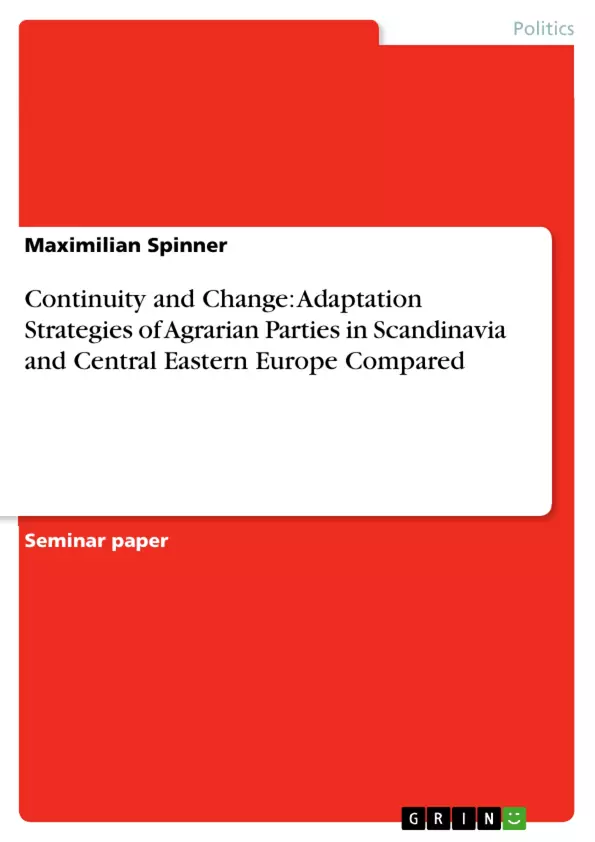This text compares adaptation strategies of traditional Agrarian Parties in Scandinavia with modern or revived Agrarian Parties in contemporary Poland and Hungary.
Inhaltsverzeichnis (Table of Contents)
- INTRODUCTION
- THE THEORETICAL FRAMEWORK
- THE HISTORICAL DEVELOPMENT OF AGRARIAN PARTIES
- .1
- .1
- .3
- THE ADAPTATION STRATEGIES OF THE SCANDINAVIAN AGRARIAN/CENTER PARTIES
- STRATEGIES OF THE POST-COMMUNIST AGRARIAN PARTIES IN POLAND AND HUNGARY
- .9
- CONCLUSION
Zielsetzung und Themenschwerpunkte (Objectives and Key Themes)
This paper examines the strategies of agrarian parties in Scandinavia and Central Eastern Europe (CEE), contrasting the successful adaptation of Scandinavian Center parties to 'catch-all' strategies with the post-communist Hungarian FKGP and Polish PSL. It seeks to understand the role of environmental change, specifically modernization, in shaping incentive structures for strategic adaptation and how organizational features interact with these strategies.
- The adaptation strategies of agrarian parties in different contexts.
- The impact of social and economic modernization on agrarian party strategies.
- The influence of organizational features on party adaptation.
- The contrasting experiences of agrarian parties in Scandinavia and CEE.
- The role of institutional environments in shaping party success.
Zusammenfassung der Kapitel (Chapter Summaries)
- Introduction: Introduces the topic of agrarian parties in Scandinavia and CEE, highlighting their historical significance and the paper's objective to compare their adaptation strategies in different contexts. The paper aims to shed light on the influence of environmental change on incentive structures for strategic adaptation and the interaction between organizational features and these strategies.
- The Theoretical Framework: Discusses the theoretical framework using Katz and Mair's approach of different party models, Panebianco's framework on the impact of organizational structures on party change, and Kirchheimer's concept of the 'catch-all party' as an aspired strategic aim. It emphasizes the role of socio-economic structures and environmental changes in shaping party adaptation.
- The Historical Development of Agrarian Parties: Explores the historical development of agrarian parties, focusing on their role in shaping the political landscape of Scandinavia and CEE. It aims to provide context for understanding their current strategies and challenges.
- The Adaptation Strategies of the Scandinavian Agrarian/Center Parties: Analyzes the adaptation strategies of Scandinavian Agrarian/Center parties, with a particular focus on Sweden. It examines how these parties have successfully reoriented themselves to remain relevant in changing socio-economic environments.
- Strategies of the Post-Communist Agrarian Parties in Poland and Hungary: Compares the strategies of the Polish Peasant Party (PSL) and the Hungarian Smallholders' Party (FKGP) with those of the Scandinavian agrarian parties. It examines the challenges they face in adapting to post-communist environments and the differences in their strategic choices.
Schlüsselwörter (Keywords)
The primary keywords and focus topics of the paper include agrarian parties, party adaptation, social and economic modernization, environmental change, incentive structures, organizational features, Scandinavian Center parties, post-communist parties, Polish Peasant Party (PSL), Hungarian Smallholders' Party (FKGP), catch-all parties, and comparative analysis.
- Quote paper
- Maximilian Spinner (Author), 2003, Continuity and Change: Adaptation Strategies of Agrarian Parties in Scandinavia and Central Eastern Europe Compared, Munich, GRIN Verlag, https://www.grin.com/document/13301



